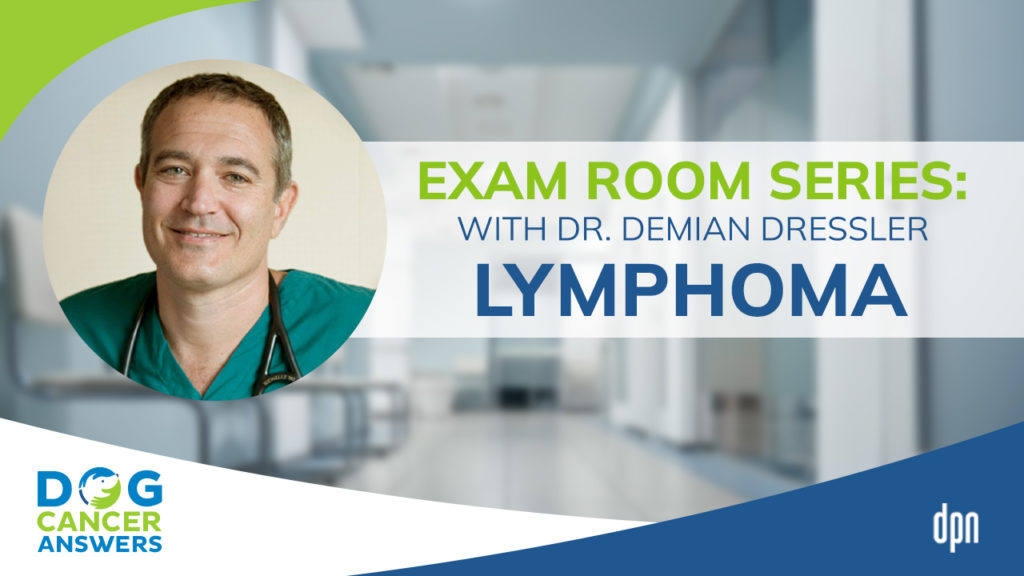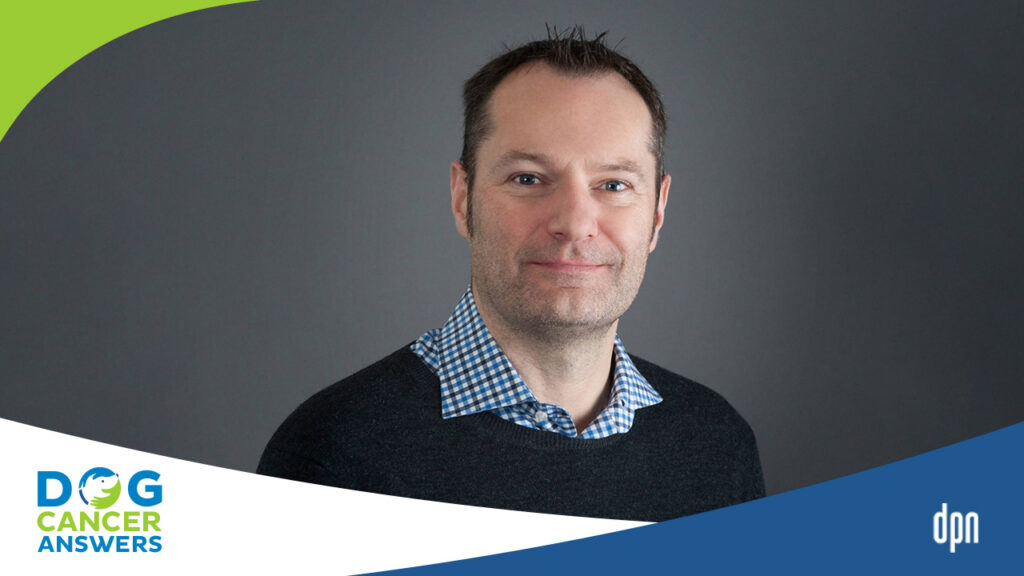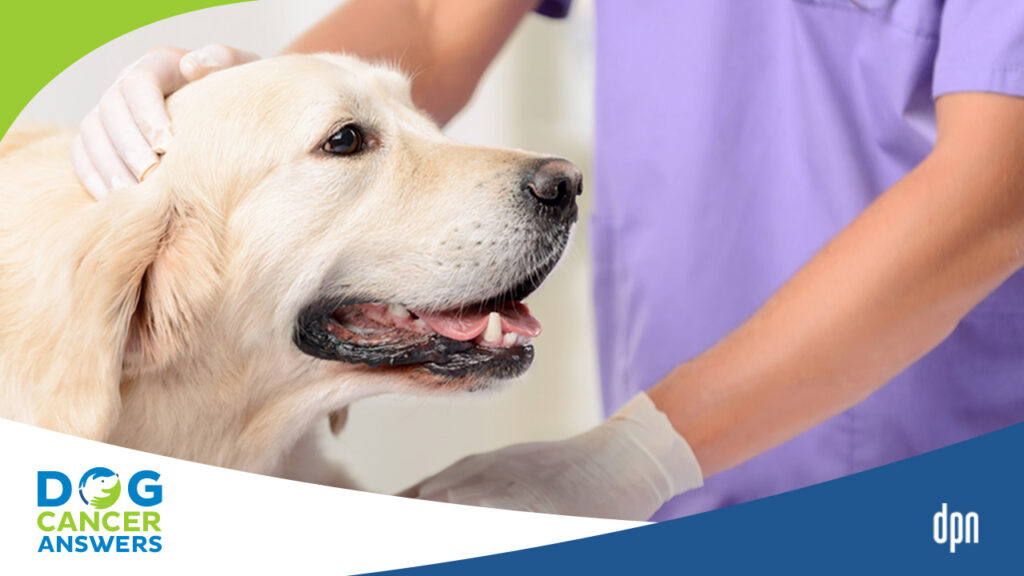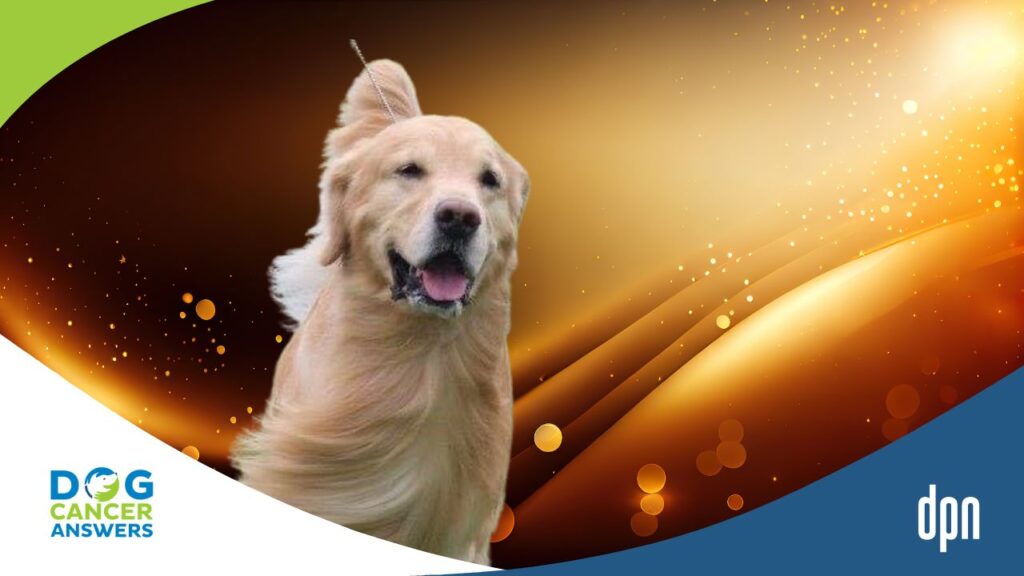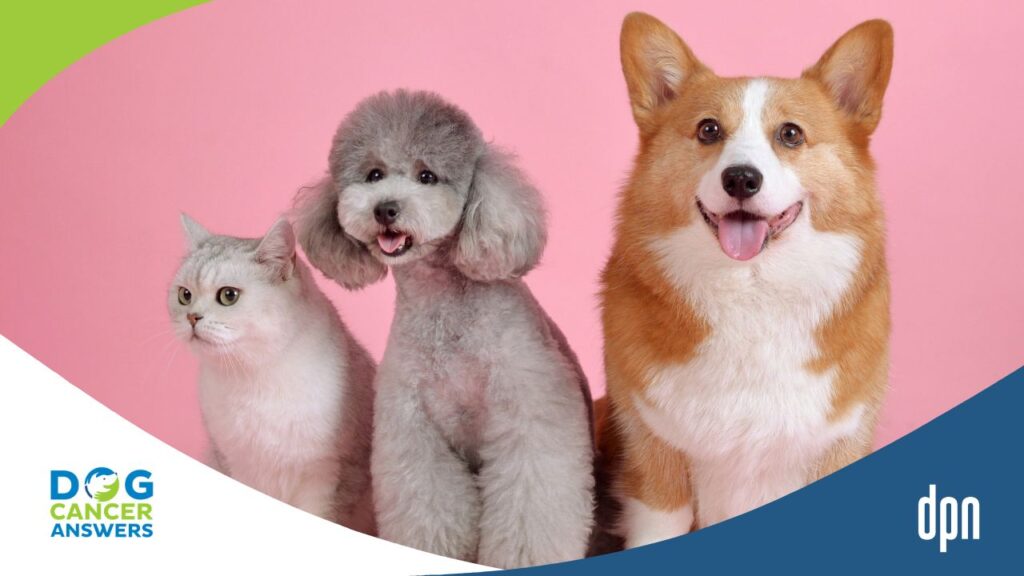EPISODE 207 | RELEASED March 13, 2023
Monepantel: A Future Treatment for Dog Lymphoma | Dr. Kim Agnew
Monepantel is a hopeful dog lymphoma treatment currently in clinical trials. This easy-to-give tablet seems to keep dogs stable and feeling good.
SHOW NOTES
If you live in Australia, New Zealand, or Texas, your dog might be eligible to join a clinical trial studying the drug monepantel.
Monepantel was originally developed as a sheep dewormer, but a scientist in Australia discovered that it killed cancer cell lines in the lab. Now, monepantel is being studied to treat B-cell lymphoma in dogs, cancer in humans, and motor neuron disease in humans.
Dr. Kim Agnew, the principal investigator on the dog lymphoma study, explains how this drug works and what results they are seeing, as well as the path to full approval. While monepantel is not going to take the place of chemotherapy, it does show promise to help slow progression of lymphoma and preserve the dogs’ quality of life for up to seven months.
Listen in to learn more, and see if this clinical trial might be a good fit for your dog!
Links Mentioned in Today’s Show:
PharmAust Dog Lymphoma Clinical Trial: https://www.pharmaust.com/petdogtrial/
[00:00:00] >> Dr. Kim Agnew: What I think to be one of the most exciting findings is that the dogs that have been on the combination therapy, Molly, they’ve pushed out sort of five to seven months.
[00:00:12] >> Announcer: Welcome to Dog Cancer Answers, where we help you help your dog with cancer.
[00:00:18] >> Molly Jacobson: Hello, friend. Today on Dog Cancer Answers, we’re taking a peek into the research and development side of dog cancer treatments. Dr. Kim Agnew is a veterinarian in Australia and he’s a consultant for the biotech company, PharmAust, which is looking into a drug called monepantel for canine cancer. It’s not quite ready to hit the shelves of pharmacies near you, but the company is hoping it will be another tool in your veterinarian’s toolkit very soon.
Dr. Agnew, thank you for joining us.
[00:00:48] >> Dr. Kim Agnew: Ah, it’s very good, Molly. It’s uh, great to be here, and looking forward to the chat.
[00:00:52] >> Molly Jacobson: So you work with a company, a biotech company called PharmAust and they are currently conducting some trials on a really interesting drug that’s currently approved in your neck of the woods, but not yet in the US. Can you tell me a little bit about what you guys are doing down at PharmAust, and what you’re working with, and what you see for the future?
[00:01:15] >> Dr. Kim Agnew: Sure. Yeah, so monepantel is a really interesting chemistry because the initial product that was generated with monepantel came from a large pharma company called uh, Novartis, and they developed monepantel from scratch as a sheep dewormer.
[00:01:34] >> Molly Jacobson: Okay.
[00:01:35] >> Dr. Kim Agnew: And so when you see, uh, trade name Zolvix, if you see that anywhere on the globe, it’ll be used for treating sheep and cattle for getting rid of internal parasites. So one of the passions I have, Molly, really is trying to short circuit the whole product development train. Like we all know how long this takes and-
[00:01:57] >> Molly Jacobson: Yeah.
[00:01:58] >> Dr. Kim Agnew: I think one of the fascinating things that PharmAust is trying to do, they’re just looking at the different ways that chemistries can act within the body and within the industry we call it repurposing. So we have a chemistry like monepantel, which is developed in an innovative sense for deworming cattle, but, ah, but hang on, we find that it actually has a lot of other effects as well. Different systems within the body.
These stories are not too uncommon when you look at the way some actives are discovered. But in this case, there was a academic physician who worked in Sydney Hospital and he happened to have some sheep. Like it’s not uncommon for people in Australia to have some sheep if you live in the country, right?
[00:02:46] >> Molly Jacobson: Right.
[00:02:47] >> Dr. Kim Agnew: And there were discussions in them, in the literature about, uh, repurposing products that were used for a different purpose to try and ascertain what else they could do within the body, right? So, um, and anthelmintics or dewormers were one of these segments. So this particular physician had finished drenching his sheep, he looked at the bottle and saw, ah, this has got monepantel in it, goes back to the lab and sets up the set of in vitro screens against various cancer cells. And hey, presto, finds that montepantel is effective against a wide range of in vitro cell lines.
So that’s kind of how-
[00:03:29] >> Molly Jacobson: Now in vitro means in glass, which means in the Petri dish in the lab, right?
[00:03:33] >> Dr. Kim Agnew: Correct.
[00:03:33] >> Molly Jacobson: So there’s a lot of things that happen in a Petri dish that wouldn’t necessarily happen in the body.
[00:03:38] >> Dr. Kim Agnew: Yes.
[00:03:38] >> Molly Jacobson: But this is exciting to find something that works in a lot of cancers in the lab.
[00:03:43] >> Dr. Kim Agnew: Yes.
[00:03:43] >> Molly Jacobson: Okay.
[00:03:44] >> Dr. Kim Agnew: Yes. That’s a really good comment. Certainly that, this is the way that initial work starts.
[00:03:50] >> Molly Jacobson: Right.
[00:03:51] >> Dr. Kim Agnew: It, does it work or not. But yeah, your points are really good.
[00:03:53] >> Molly Jacobson: Okay. So he sees this great result. And he says, wow, the sheep dewormer is killing cancer cells.
[00:04:01] >> Dr. Kim Agnew: Yes. So, so fundamentally, the company was started – obviously there were discussions around intellectual property, but the company was started on this basis. And uh PharmAust is a listed company in Australia. Little bit unusual for, for small biotechs. But they are focused on both human and canine applications of, uh, monepantel. So.
[00:04:28] >> Molly Jacobson: Okay.
[00:04:29] >> Dr. Kim Agnew: So we will obviously will be talking around the canine study today. The PharmAust as a, as a company is also looking at monepantel use in people also for oncology, for cancer. And the other real fascinating area they’re looking at is, uh, motor neuron disease actually, for people, which is huge unmet need and really debilitating. So yeah, it’s got a lot of potential opportunities.
[00:04:55] >> Molly Jacobson: Say that again, a motor neuron disease.
[00:04:58] >> Dr. Kim Agnew: Yeah. Lou Gehrig is one name for it.
[00:05:01] >> Molly Jacobson: Oh, Lou Gehrig’s Disease.
[00:05:02] >> Dr. Kim Agnew: Yeah.
[00:05:02] >> Molly Jacobson: Oh, wouldn’t that be amazing?
[00:05:04] >> Dr. Kim Agnew: It would be.
[00:05:04] >> Molly Jacobson: So what’s the mechanism that you’re looking at and is it the same mechanism for a motor neuron disease like Lou Gehrig’s and cancer or are they different things that it’s doing?
[00:05:14] >> Dr. Kim Agnew: Yes. Look, we think that the end result, the end mechanism is the same, but maybe slightly different pathways. So in a dewormer, simply what it does, it blocks transmissions to muscles, right, so paralyzes the parasite.
[00:05:30] >> Molly Jacobson: Okay.
[00:05:30] >> Dr. Kim Agnew: But within oncology and within the motor neuron mechanism, uh, monepantel’s found to affect the whole energy flow system within the cell. And this is a really, it’s a really complex pathway. It’s called the mTOR pathway, and it’s got multiple feedback loops that control all sorts of aspects to it. But fundamentally, Molly, what happens is that, let’s say the body we’re in a, in a starvation condition, then what the system does is start, it starts to remove some of our cells to feed the body, right?
So it manages, if you’re in a flux of lots of energy, the system trucks away in the background. If you, um, are getting hungry or you’re starving, then it activates different systems. So it ends up actually killing some cells.
[00:06:24] >> Molly Jacobson: Oh.
[00:06:24] >> Dr. Kim Agnew: Right. So what happens in the cancer cell, which is rapidly growing and it’s using lots of energy, what monepantel does is that it slows this whole energy process down and starves the cell, right? So then the cell, the immune system comes in and actually removes the cell and degrades the cell. So this is the high level view of how monepantel works.
[00:06:52] >> Molly Jacobson: That’s fascinating. I wanna make sure I really understand this and that our listeners do too. So I’m thinking about like photographs of someone who’s truly starving, right? They’re emaciated and you can see the flesh is really dissolved and they’re skin and bones. That’s literally because something in the body, this energy system, has said, gosh, there’s no food coming from the outside, I’m gonna have to eat my own flesh in order to survive.
So I will go and break down muscle and I’ll go and break down other tissues, use them for energy to keep myself going in the hopes that food will start to come in from the external environment. Am I correct so far?
[00:07:31] >> Dr. Kim Agnew: Yes. Yes.
[00:07:32] >> Molly Jacobson: So this system that monepantel is involved in slows that whole breakdown of tissues down, and so the cancer cells that are growing, growing, growing, growing, growing, become like a target for the monepantel, and they say, slow down, slow down, slow down. And so the tumor basically, in effect goes into the starvation mode.
[00:07:54] >> Dr. Kim Agnew: Yes, yes. So there’s a process called, uh, autophagy, which is the destruction of cells. So that’s, in the end, that’s what monepantel induces within the body. And what’s interesting is that-
[00:08:07] >> Molly Jacobson: That’s almost as devious as cancer.
[00:08:09] >> Dr. Kim Agnew: Yes, yes.
[00:08:11] >> Molly Jacobson: You can use that.
[00:08:12] >> Dr. Kim Agnew: Yes, that’s right. Yeah.
[00:08:16] >> Molly Jacobson: Wow. So it really just starves that tumor of energy.
[00:08:22] >> Dr. Kim Agnew: Yes.
[00:08:22] >> Molly Jacobson: So what does it look like in the body in these trials? Because you’re now moved into trials, so you’re conducting actual trials in real live bodies.
[00:08:30] >> Dr. Kim Agnew: Yes. So what we’ve done in canine study to date, we are still, we’re still quite early in the, in the study Molly, but we’ve enrolled 34 dogs now. And what PharmAust has been doing over this time, which has probably taken 18 months to two years to enroll these dogs, and we have, we have sites in Australia, um, we’ve recently, just this year set up a site in New Zealand and we have one site in the US as well now.
[00:09:01] >> Molly Jacobson: Okay.
[00:09:01] >> Dr. Kim Agnew: And over the last two years, really it’s just been a case of looking at dose and making sure we can titrate the dose to the effect. And I think maybe one of the interesting things your listeners may appreciate understanding is that monepantel is not, it’s not a cytotoxic like a, a chemotherapy type program. But what this does is, is produce quite a different outcome within the dogs.
So it’s still really clear that chemotherapy in dogs is still the gold standard for those owners who want to preserve their dog’s life for as long as possible. And monepantel will not replace chemotherapy in terms of duration of outcome.
[00:09:48] >> Molly Jacobson: Okay.
[00:09:48] >> Dr. Kim Agnew: But because it’s not a cytotoxic, then it, it, it produces less impacts on, on the body. So what you tend to see in the dogs that we’ve investigated so far is that those dogs that respond well to monepantel, the lymphoma goes, almost goes into a, a stasis. Like it’s managed. So the dog, the dog’s quality of life actually is, in some cases, owners have said it’s, it’s sort of back to how it was before they had observed them getting ill. It doesn’t cause the tumors to go into regression.
[00:10:25] >> Molly Jacobson: Okay.
[00:10:25] >> Dr. Kim Agnew: Um, but it allows the dog to manage their lymphoma effectively as they would normally. And the convenience that, of the administration that PharmAust has got is a daily tablet, right? So once the initial diagnosis is made, the tablets are prescribed, they go back, and the owner can then just freely medicate on a daily basis, uh, according to the instructions.
[00:10:51] >> Molly Jacobson: This is a, this is a sheep dewormer. So this is something that’s safe to handle, I imagine, unlike many chemotherapy drugs, whether given as an injectable or at home in, in tablet form.
[00:11:02] >> Dr. Kim Agnew: Yes. Yeah, correct. And there’s no, like, there’s no need for hospitalization for intravenous drips or those, those sorts of things. So, and so the outcomes tend to be an outcome of stasis, and also there’s no need for owners or children not to be able to handle the dogs after chemo or some other medications. They’re obviously, for safety reasons, there are sometimes three days or five days where it’s best not to touch secretions from, from the pet, right? So monepantel doesn’t create those levels of sort of handling challenges with your pet.
[00:11:41] >> Molly Jacobson: That’s pretty incredible. So you mentioned lymphoma. Do all of the dogs in all of your different trial sites have lymphoma?
[00:11:50] >> Dr. Kim Agnew: Yes, yes. So the trial is specifically for treatment naive B-cell lymphoma.
[00:11:55] >> Molly Jacobson: Okay.
[00:11:56] >> Dr. Kim Agnew: So all our cases, all our cases are treatment naive B-cell lymphoma.
[00:12:01] >> Molly Jacobson: Meaning that they’re not doing any other, they’re not doing chemotherapy. Treatment naive, meaning nothing else has been done. They’re only getting monepantel.
[00:12:09] >> Dr. Kim Agnew: Correct. Yes.
So there’s not, there’s quite a stringent enrollment criteria as you can imagine, but the company really wanted to assess monepantel – this is the first time monepantel’s obviously been assessed in dogs, so you want to make sure that there’s no complications in terms of previous therapies or outcomes that might cloud the findings.
[00:12:30] >> Molly Jacobson: So these must all be owners who are declining chemotherapy to begin with, and then they’re offered this as, is that how they get into the trials?
[00:12:39] >> Dr. Kim Agnew: Yes. Well, there’s, there’s certainly, and it’s quite an interesting question when you think around, same with people, like the reasons, the reasons why people think about different mechanisms of managing cancer. So what they do in themselves and obviously with their pets. The choice has really been made on a couple of things. One is that chemotherapy itself is something that they are a bit concerned about. There’s the time, sometimes it’s the logistics, there’s the costs, you know, the outcomes and the side effects sometimes concern people.
We’ve had owners who have had chemotherapy themselves and, um, don’t want to use that on their dogs. Some people hear about the study ’cause there is a reasonable amount of media activity that PharmAust put out and testimonials on the website from owners who have been involved in the study. And so sometimes, as a curiosity, you know, what is this new chemistry and can it help my dog, and how does it fit. So sometimes there’s just that scientific curiosity that owners want to explore as well.
[00:13:50] >> Molly Jacobson: Yeah, that’s, those are our listeners. A lot of them have sort of a, a natural scientific curiosity themselves, and they encounter a terrible diagnosis for their dog and they’ve become very knowledgeable about something they didn’t wanna become knowledgeable about, not just because it’ll help their dog, but because they’re naturally curious people.
[00:14:09] >> Dr. Kim Agnew: Yes.
[00:14:10] >> Molly Jacobson: That’s interesting. So why are you looking at lymphoma instead of some other illness, other cancer type? What was that decision making process about?
[00:14:19] >> Dr. Kim Agnew: Yes. So look, I think, um, that was, decision was made a bit before my time with PharmAust. But the understanding I have is that there’s a couple of key things. One is that lymphoma in dogs is obviously closely related to Hodgkin’s in people.
[00:14:35] >> Molly Jacobson: Okay.
[00:14:35] >> Dr. Kim Agnew: Right. So there’s, there’s real similarities in sort of genetic causes, there’s T and B-cell makeup, the speed of progression, there’s lots of similarities. And because PharmAust has a, a human arm as well, then the, um, data generated from lymphoma in dogs certainly would help think about Hodgkin’s in people. So there is, there is that aspect. The other aspect really is, is that lymphoma is such a devastating disease for, for dog owners.
[00:15:09] >> Molly Jacobson: Yeah.
[00:15:10] >> Dr. Kim Agnew: It’s incredibly aggressive. And if it’s not treated, then really once you, once you find your dog has this diagnosis, it’s months, if you’re lucky, one to two months without any treatment.
[00:15:21] >> Molly Jacobson: If you’re lucky.
[00:15:22] >> Dr. Kim Agnew: If you’re lucky.
[00:15:23] >> Molly Jacobson: Yeah. Three to four weeks for many.
[00:15:25] >> Dr. Kim Agnew: Yes. And so I think there was a mix of things, but again, if you think around developing data for a new oncology product, then something like lymphoma is a challenging one because it is so aggressive, as you say, Molly. But the speed of progression actually lets you assess the chemistry quite quickly because you know within one to two months whether this is gonna work or not, right. So, so there is that aspect as well.
[00:15:54] >> Molly Jacobson: That’s interesting.
[00:15:55] >> Dr. Kim Agnew: Yeah.
[00:15:55] >> Molly Jacobson: Yeah. You know quickly. I guess you, you started the trials and you’re like, well, the dogs are still here and they’re doing well.
[00:16:01] >> Dr. Kim Agnew: Yeah. That’s it.
[00:16:03] >> Molly Jacobson: Yeah. Pretty quickly. That’s really interesting. And then why B-cell as opposed to T-cell? Is it because of that Hodgkin’s connection or is it just narrowing it down and eliminating as many variables as possible, or?
[00:16:16] >> Dr. Kim Agnew: Yes. Yeah, just that I think the B-cell is, is much more common generally than T-cell, so.
[00:16:22] >> Molly Jacobson: Yeah.
[00:16:23] >> Dr. Kim Agnew: Yes, I think it was more just trying to narrow the, the spread of investigation.
[00:16:29] >> Molly Jacobson: So if it’s working relatively well in these trials, and these are early trials, so this is not yet available as a treatment, right, for the general population, but do you see, looking into the future in your crystal ball, do you see that possibly it could be of use in other cancer types?
[00:16:47] >> Dr. Kim Agnew: I think the answer is yes, but the data is quite limited. Certainly-
[00:16:52] >> Molly Jacobson: Sure.
[00:16:52] >> Dr. Kim Agnew: I mean, there’s a publication for a small scale phase one study in people-
[00:16:58] >> Molly Jacobson: Okay.
[00:16:59] >> Dr. Kim Agnew: -which has been published on, on, uh, monepantel, which is indicating positive outcomes in things like ovarian cancer and, and I think gastric cancer was another one.
[00:17:10] >> Molly Jacobson: Wow.
[00:17:10] >> Dr. Kim Agnew: But in dogs, uh, really the B-cell lymphoma really is the most significant data set that exists for monepantel.
[00:17:19] >> Molly Jacobson: Well, lymphoma is the most common cancer type, and B-cell, as you pointed out, is more common than T-cell. So this would be a great thing. Now, one of the, you know, often if someone decides they don’t wanna go through a standard, you know, gold standard chemotherapy protocol like the CHOP protocol for lymphoma, the next step down treatment option they’re given is prednisone, because it’s relatively inexpensive, we know a lot about it, it’s used, it’s easily available.
So how does prednisone and monepantel, how do they match up to each other as options from what you know with this early data?
[00:18:02] >> Dr. Kim Agnew: It’s a really good question that one, because ideally if you think around, you know, when a vet talks to the owner about prednisone, right, you’re thinking of palliative care. You’re thinking, let me just try and make-
[00:18:16] >> Molly Jacobson: Yes.
[00:18:16] >> Dr. Kim Agnew: -the time as, as-
[00:18:18] >> Molly Jacobson: Give me a little extra time.
[00:18:20] >> Dr. Kim Agnew: Yeah, that’s right. And monepantel itself, as I’m saying, is not gonna be a competitor for the duration provided by chemotherapy. Bearing in mind that most chemotherapy programs are four to five, six months sometimes in, in duration. But the data that we’ve got from a monepantel on its own versus nothing, it’s clear that monepantel does have a significant impact on reducing progression of disease. So what we’re finding in those dogs that get through – a study, Molly, is 28 days.
[00:18:59] >> Molly Jacobson: Okay.
[00:18:59] >> Dr. Kim Agnew: And again, that’s set up for B-cell lymphoma. So we assess three times during the 28 days. So at day 28, we’ll make a decision, and we’re totally aligned to the standard VCOG RECIST criteria, which are, for your listeners, is really the accepted way, the global accepted way of assessing outcomes of studies, right?
[00:19:21] >> Molly Jacobson: Right.
[00:19:21] >> Dr. Kim Agnew: So, and so what we find is that dogs that do well, and tumors are tumors, but uh, the dogs that do well on monepantel remain in static disease at day 28. And that would be related, really we think to the entry point, the health of the dog at, at the start of the study.
[00:19:44] >> Molly Jacobson: So whatever the dog is at the beginning, they’re still there 28 days later. They haven’t gotten worse. And that’s uncommon with lymphoma.
[00:19:53] >> Dr. Kim Agnew: Yes.
[00:19:53] >> Molly Jacobson: Because you notice your dog has a lump under their jowl or in their armpit, you bring them in and you find out it’s lymphoma, sometimes it, it’s a week later, they have lumps popping up all over the place and it’s really quite something. So it progresses very fast and is very serious and that can cause all sorts of other problems that are related to having lumps all over your body that, you know, hard to breathe, that it’s hard to move, it’s very painful for the dog.
So having like one lump and then 28 days later, you’re saying it would be like that same lump would probably still be there, but not be bigger, and no other lumps would’ve appeared, for example.
[00:20:34] >> Dr. Kim Agnew: Yes. Yes. So what generally happens is that, um, dogs will present with multiple lymph nodes that are larger, right? So multiple lumps. And so the dogs that remain stable then what we find is that the node measurements by the oncologist, they can be reduced. Because there is this grading between sort of minus 30 to plus 20% of node measurement.
[00:21:00] >> Molly Jacobson: Okay.
[00:21:00] >> Dr. Kim Agnew: So if it sits within, if it reduces say 20% or it goes up 10%, that’s called stable disease. So within the variations, we’re finding those dogs, uh, are maintaining stability. But one, one thing that we have found, and this is on the website so I can talk about it, is that a retrospective analysis of dogs that are, had ongoing treatment – so at day 28, what PharmAust says to the oncologist and the owner is that, well, if you, if you’re really happy with the way monepantel’s going and you want to continue with the study, they will, um, happily support ongoing medication with, uh, monepantel. And what, some oncologists did over the last couple of years is that – because PharmAust doesn’t have any impact on the decisions, it’s all between the oncologist and the owner –
[00:21:54] >> Molly Jacobson: Okay.
[00:21:55] >> Dr. Kim Agnew: But some oncologists made a call to, okay, well let’s, um, let’s say a dog does get to progressive disease at day 28, but for all intents and purposes is behaving normally. And this is actually not too uncommon. Still with energy, eating well, but the nodes have grown a bit more and they’re outside the criteria for, to call it stable disease. So some of those dogs will then go on to a combination of monepantel with prednisone.
[00:22:23] >> Molly Jacobson: Oh.
[00:22:24] >> Dr. Kim Agnew: And at varying dose rates. But what I think’s been one of the most exciting findings is that the dogs that have been on the combination therapy, Molly, have actually, they’ve pushed out sort of five to seven months. And again, this is a retrospective analysis of data which really needs to be set up and assessed properly in a proper study.
[00:22:49] >> Molly Jacobson: In a study.
[00:22:50] >> Dr. Kim Agnew: But it’s an interesting finding out of this early stage data. ‘Cause there’s some similarities actually with the way prednisone works and the way monepantel work on the cancer cell. And I’m not sure of the mechanism at all, but the interesting finding is that potentially there’s longevity of survival. We’ve had a number of dogs that have gone through sort of six to seven months of good quality of life after their initial presentation to the study and, and I think this is an area of real unmet need within therapies of lymphoma for dogs.
So I think for PharmAust, um, this is something that they’re really wanting to explore further with more investment and much bigger studies.
[00:23:40] >> Molly Jacobson: Yes. Because these smaller, how many dogs are in these, in these studies? Is it 34?
[00:23:44] >> Dr. Kim Agnew: 34. 34 at this stage.
[00:23:46] >> Molly Jacobson: 34.
[00:23:47] >> Dr. Kim Agnew: Yeah.
[00:23:48] >> Molly Jacobson: So it’s not nothing, but it’s not hundreds of dogs. Or how many dogs would you like to see in a study?
[00:23:54] >> Dr. Kim Agnew: If the decision was to really – and we’d call this a phase three – we would go, we’d, I’d like to see a hundred dogs.
[00:24:02] >> Molly Jacobson: A hundred dogs. Yeah.
[00:24:03] >> Dr. Kim Agnew: Yeah.
[00:24:03] >> Molly Jacobson: That’s a nice round number. And you can get good percentages.
[00:24:06] >> Dr. Kim Agnew: Yes. That’s right.
[00:24:07] >> Molly Jacobson: That are easy to understand.
[00:24:09] >> Dr. Kim Agnew: That’s right. Yeah. Do the math, it’s easy for me. It suits me quite well.
[00:24:13] >> Molly Jacobson: I’d bet a thousand would be nice too, that’s another one you can good percentages, you don’t have to do too much hard math.
[00:24:19] >> Dr. Kim Agnew: That’s right.
[00:24:20] >> Molly Jacobson: Well, that’s a good place for us to stop just for a moment to listen to our sponsors for today’s show. And then when we come back, Kim, I want to ask you about another dewormer that is being repurposed.
And we’re back with Kim talking about monepantel. One question I know is going to come up in the mind of the listener as they hear you speak about a sheep dewormer called monepantel is, oh, is that like ivermectin? So please, is monepantel ivermectin, and what is the difference?
[00:24:57] >> Dr. Kim Agnew: Yeah, so if you think around my term "repurposing," then that term applies both to ivermectin and monepantel and, and some other chemistries, right? Ivermectin and monepantel are totally different chemistries. They’ve got a very different mode of action as dewormers, and so from that sense, they are unrelated. From a related sense, it’s obvious that ivermectin also has been around for 30 or 40 years, and it has other things that it does to cells as the same way that monepantel does.
And, and honestly, one of the exciting things being a, a bit of a science geek is that chemistries can be around for decades, but people are still working out things that they do, right? This science doesn’t stop.
[00:25:53] >> Molly Jacobson: Right.
[00:25:53] >> Dr. Kim Agnew: So I think if there’s a connection, it’s just that they, both actives do a lot of different things besides what they’re initially commercialized for, and that’s maybe one of the cool things about being a scientist.
[00:26:06] >> Molly Jacobson: I think my favorite repurposing is Viagra, which was-
[00:26:11] >> Dr. Kim Agnew: Yes.
[00:26:11] >> Molly Jacobson: -mildly effective as a, as a heart drug, but very effective, just let’s say it, a stimulant. I know it’s not a stimulant, but I’m not quite sure how to say that on Dog Cancer Answers, which is a family friendly show and I think we should keep it that way.
[00:26:31] >> Dr. Kim Agnew: Yes. Well, I think if you think around serendipity.
[00:26:34] >> Molly Jacobson: Uh huh.
[00:26:35] >> Dr. Kim Agnew: Like there’s another chemistry I would-
[00:26:37] >> Molly Jacobson: So to speak.
[00:26:38] >> Dr. Kim Agnew: Yeah, indeed. You know? Yes. It’s my blood pressures. Yes, that’s right. You’re right. But there’s quite a few stories about how things are discovered. There was one parasiticide, which I worked on for about 10 years, and that, the story there was a, um – a lot of these things are discovered in soil, right? I mean they, that’s a whole nother area of mine that I’ve got interest in, is just naturally derived chemistries and uh, and so ivermectin is obviously from a soil organism and um, this other chemistry was as well. And the, the person who discovered it, if you like, was camping in the Caribbean is how the story went, and sat down next to a spot on the creek and realized there was not many mosquitoes or sandflies around here. And I guess this is some creative license, but apparently took some soil samples and went back to the lab and isolated out this particular organism which produced this um, it’s one of the safest parasiticides. It was called, well it’s called Spinosad, actually, which is a great one. So there is another story of just how things start.
[00:27:52] >> Molly Jacobson: Yeah. If you keep your mind open and curious, I think humans are natural scientists when they’re relaxed and open-minded, right?
[00:28:00] >> Dr. Kim Agnew: Let’s never stop asking questions. I think that’s the key thing.
[00:28:03] >> Molly Jacobson: I agree.
[00:28:04] >> Dr. Kim Agnew: Yeah.
[00:28:05] >> Molly Jacobson: So talk a little bit about side effects and conflicts with other – it’s being used in combination with prednisone. How does that affect the dosing of other drugs? Are there side effects to monepantel when you take continually, ’cause it’s once a day, rather than a short course like you would do for a dewormer in a sheep or cow? Go ahead talk a little bit about those things.
[00:28:28] >> Dr. Kim Agnew: Yeah. When the first studies were started with, uh, monepantel, you know, what you tend to try and do is you tend to find a dose rate which you really think has every chance of working ’cause you want to assess it quite quickly. So the first dose rate that was started, there were two aspects which are quite different to the dose rate we use now.
One is it was the highest dose rate that was used, to give it a good effect, but also the delivery vehicle wasn’t the tablet. It was a, certainly a precursor to the tablet. And there were some issues there with, uh, palatability for the first one.
[00:29:08] >> Molly Jacobson: Oh.
[00:29:09] >> Dr. Kim Agnew: But it was really clear though, to your question on the adverse effects, that if monepantel dose was too high, then what you see, um, you see some impacts on the liver. And this relates to reducing feed intake. And so you do get some inappetence and some weight loss, which is obviously not preferred when you’ve got an oncology patient, right? So.
[00:29:34] >> Molly Jacobson: Right. You don’t want them to lose more weight.
[00:29:37] >> Dr. Kim Agnew: Yes, yes.
[00:29:38] >> Molly Jacobson: Yeah.
[00:29:38] >> Dr. Kim Agnew: But we don’t see gastric, we don’t see diarrhea, we kind of don’t see skin lesions. So that’s really been the major thing that we’ve seen, but we’re very mindful now about the impact of dose rate on the liver. That’s really the target organ of change.
[00:29:56] >> Molly Jacobson: So do you monitor the liver values and then lower the dose if you see change?
[00:30:01] >> Dr. Kim Agnew: Yes. So what we do now with the study, so we will do, to enroll the dog in the study, there’s a full clinical examination. This involves blood tests, obviously. We image, we do radiographs of the chest. We ultrasound the abdomen. We type the tumor. So we get a really full picture at day zero. And then we, day 14, we will do a full blood test again. And then on day 28, we’ll repeat everything. Imaging, blood tests. So we’ve got a really good idea on liver enzyme values, kidney function, you know, all the electrolytes.
We know we’ve got some good information there. And certainly by moving to a different dose and we’ve gone to a lower dose now we, and so we have a dose regimen where we start with what we call a loading dose, which is a, a higher dose than we would maintain on. And the idea behind that is that, as I mentioned, um, monepantel works through the energy system of the cell. So it takes a couple of days to initiate that effect. Like a cytotoxic drug will come straight in and if that cell is dividing and it’s at the level, then it will start killing the cell.
[00:31:21] >> Molly Jacobson: Right.
[00:31:22] >> Dr. Kim Agnew: Monepantel is a slower uptake.
[00:31:25] >> Molly Jacobson: Okay.
[00:31:25] >> Dr. Kim Agnew: So we have moved to an initial high dose to start with and then, um, we’re probably looking – again without too much detail – probably looking at between a five and a tenfold reduction of the first dose where we found the liver issue, right? And the, so we’ve dropped the dose quite significantly for the last part of the study.
[00:31:48] >> Molly Jacobson: And that is resulting in stabilization of the cancer progression as far as you can tell from your results so far. That hitting it hard and fast at a high dose and then dropping it way down for maintenance through those 28 days, is working out.
[00:32:04] >> Dr. Kim Agnew: Yes, and, and we keep a close eye on, and so we take blood levels for assessing the levels of the monepantel in the blood.
[00:32:12] >> Molly Jacobson: Okay.
[00:32:12] >> Dr. Kim Agnew: So we now believe we’ve got a, a much clearer idea of the plasma levels that we need to achieve stability with the lymphoma. So we’re matching, you know, that’s really been the work that we’ve done is to try and match outcome with dose, with plasma levels of the monepantel.
[00:32:33] >> Molly Jacobson: I see. And then in your larger trials, you can take what you’ve learned here and really look at that in a more detailed way with a larger set of dogs.
[00:32:43] >> Dr. Kim Agnew: Yes.
[00:32:43] >> Molly Jacobson: Are you focusing on certain breeds or size of dogs, or are you just looking at the naive treatment B-cell lymphoma dogs?
[00:32:54] >> Dr. Kim Agnew: Yes. Yeah. Look, we’ve not selected on anything in terms of breed, size, shape, apart our size really is related to, at the moment, we’ve got a minimum of 11 kilos.
[00:33:06] >> Molly Jacobson: Okay.
[00:33:07] >> Dr. Kim Agnew: So 20 pounds, but that really relates to the tablet size that the company’s got. It’s just a bit difficult to-
[00:33:14] >> Molly Jacobson: Ah.
[00:33:14] >> Dr. Kim Agnew: So it’s not a toxicity thing, it’s more just a, we, we don’t quite have a tablet size that fits small dogs.
[00:33:20] >> Molly Jacobson: Right. If you make it commercially, you’ll make it though, I imagine.
[00:33:24] >> Dr. Kim Agnew: Yes. Well, I’m, again, that’ll be someone else’s decision, Molly, but I would definitely, that would make sense to me. Yeah.
[00:33:34] >> Molly Jacobson: Oh, well, I, I have small dogs, so that’s what I’m interested in.
[00:33:39] >> Dr. Kim Agnew: I hear you.
[00:33:40] >> Molly Jacobson: So tell me a little bit about how this works, where this is not a drug that’s approved in the US. As a US based show, I’m interested in – ’cause you have a, a trial center here in the US, how does that work to use a drug that we don’t have on our shores?
[00:33:57] >> Dr. Kim Agnew: Yes. There’s a, there’s a facility and we, we work with a, actually a good friend of mine who’s a US regulatory, uh, person in the US. And there is, there is an ability to, before you submit your INAD, which we would have to do to do a larger scale study, and we would have to have a lot more data available. You can look at a 10 dog study.
So we’ve got a very small pilot study that we’re running in Texas. And that’s really just to let us, again, get some connections with oncologists in the US, um, but to have some local data which we would submit alongside everything else that we needed to do the INAD submission, which if hopefully if enrollment rates pick up – and it’s a bit of a plug for the study to your readers that enrollment rates-
[00:34:50] >> Molly Jacobson: Oh, we’re happy to do that.
[00:34:52] >> Dr. Kim Agnew: Yeah.
[00:34:52] >> Molly Jacobson: Anybody who wants to get involved in these trials, they sound like they’re well worth it.
[00:34:56] >> Dr. Kim Agnew: Please.
[00:34:57] >> Molly Jacobson: I imagine anybody in Australia could ask their vet to get enrolled, is that how this works?
[00:35:01] >> Dr. Kim Agnew: Yeah, look, so there are certain sites that we’ve got lined up for the study. Probably, if owners wanted to they could just go onto the PharmAust website.
[00:35:10] >> Molly Jacobson: Okay. We’ll put a link in the show notes for them.
[00:35:11] >> Dr. Kim Agnew: Yes. And there would be media.
[00:35:14] >> Molly Jacobson: Yeah.
[00:35:14] >> Dr. Kim Agnew: Um, you can see where the sites are run. Obviously my details or Dr. Roger Aston, who’s chairman of the board. I’m very happy to take calls. And then if there’s any interest, in fact, I was speaking to an owner from New Zealand the other day who just heard about the study in New Zealand and, um, so I chatted with her for half an hour about their pet and options. And so I’m very happy to, to do that as well.
[00:35:41] >> Molly Jacobson: Okay, well that’s really nice. So you have sort of a, you’re a hands on company. So you have trial sites in Australia, New Zealand, and one in the US. Is there anywhere else?
[00:35:51] >> Dr. Kim Agnew: No.
[00:35:52] >> Molly Jacobson: Do you want to be somewhere else?
[00:35:54] >> Dr. Kim Agnew: Look, I think, I think you, you hit it a little bit to say, well, we’re quite a small company, and like I’m the, I’m the lead investigator. So, you know, you don’t wanna spread too wide.
[00:36:05] >> Molly Jacobson: Yeah.
[00:36:05] >> Dr. Kim Agnew: We want to keep focused in areas and, um, so at the moment, I’m really comfortable with the sites that we’ve got.
[00:36:12] >> Molly Jacobson: It’s manageable.
[00:36:13] >> Dr. Kim Agnew: Yes it is.
[00:36:15] >> Molly Jacobson: So when, if someone’s listening and they think, okay, my dog’s just been diagnosed with B-Cell lymphoma, I haven’t made a choice yet, how do they know their dog is right for this trial? How would you assess that? Who should be enrolling?
[00:36:32] >> Dr. Kim Agnew: Yeah, so the, um, obvious place is to start having a chat with your own veterinarian, right? And um, and if they have not heard of the study, then feel free to reach out directly to PharmAust or, um, we can direct to the oncologist. But the initial examination really is the key. So, if your pet has just been diagnosed, seemingly quite normal, energy’s the same, appetite’s the same, that would be very likely to be substage A.
So we, we really, if there’s a, an area that we are limiting is, um, enrolling substage B dogs is not something that we’ve done. So every dog that we’ve had, you know, they could be stage five. So we are not, we’re taking any stage through to stage five. Um, but substage B is, is a group that we’re not enrolling because generally those dogs sadly are just, they’re just too ill to manage.
[00:37:30] >> Molly Jacobson: They’re very ill.
[00:37:31] >> Dr. Kim Agnew: Yes.
[00:37:32] >> Molly Jacobson: When they’re substage B, that’s when they’re really, really, yeah, I understand. So in the interest of kindness to the dog-
[00:37:38] >> Dr. Kim Agnew: Yes.
[00:37:39] >> Molly Jacobson: -you take the dogs who are in pretty good shape, have lymphoma, we’re not, it’s an urgent situation, but they’re still doing pretty well, hoping that you can keep that quality of life stable.
[00:37:50] >> Dr. Kim Agnew: Yes. And one of the things the oncologists, as we’ve talked around, find it difficult is that, you know, you have a 28 day study. It doesn’t sound long, but as you’ve pointed out a couple of times, Molly, for a lymphoma dog, it can be really challenging. So we really like substage A one, as you say, to be trying and be, um, fair to uh, and look after the welfare of the dog as best we can given a quick moving into a study situation.
But then again, if we have ill dogs and unfortunately they pass away in a week or two weeks, then that’s not an effective outcome for anyone either. So yeah.
[00:38:30] >> Molly Jacobson: Right. And that would leave for me a bad taste in my mouth.
[00:38:33] >> Dr. Kim Agnew: Yes.
[00:38:34] >> Molly Jacobson: Potentially as a, as a dog lover to think it didn’t do anything for my dog and I had hope. And that seems like a kindness for everybody, ’cause emotions run so high around cancer. It’s just heartbreaking, isn’t it? It’s heartbreaking for veterinarians as much as it is for the dog lover.
[00:38:51] >> Dr. Kim Agnew: Yeah. And, and it’s really, it’s quite emotional at times when you see the thinking owners go through about how to manage their pet with cancer, right? And, and often, well, I say often, I have observed owners who will make decisions to look after their pet in a kinder way, maybe that’s a different phrase for people, but they might put themselves through more aggressive therapy than they would actually allow their pet to go through because they’re responsible, right, for the outcomes.
So the initial chat and the investigation and the discussion with the oncologist and the owner and, is, that’s really where it all has to happen. This is where the key decisions are made and expectations. It’s really important that, and I know categorically oncologists are really open about what they think about the study. They don’t wanna create false hope. They want to create good expectations.
So I’m really proud to work with these oncologists because they always have the animal welfare top of mind. ‘Cause people need to know the ranking, obviously, of the therapies, right? So gold standard, chemotherapy, that’s it. Palliative therapy. And then we are thinking that this option could be something in the middle, which provides a, a different opportunity. But it’s still a study. It’s still a, an early stage investigation study, so.
[00:40:19] >> Molly Jacobson: Yeah, we’re not there yet. It’s not a treatment yet, but it’s possibly a peek into the future.
[00:40:24] >> Dr. Kim Agnew: Indeed, hopefully. Yep.
[00:40:25] >> Molly Jacobson: Yes. Well, Kim, thank you so much for joining us today. I really appreciate it.
[00:40:30] >> Dr. Kim Agnew: I’ve been great to be here, Molly, enjoyed the chat and good luck to everyone listening.
[00:40:37] >> Molly Jacobson: And thank you listener. I am really excited about monepantel in part because sometimes the old drugs that we know for one use really do have potential in other areas, and it takes, uh, scientists like Kim to go and find those uses and put in the time and effort it takes to build the trials and do the science that we need to do in order to know for sure whether something that is currently being used in one application could be used in another.
Obviously, monepantel’s in studies now, it’s early days yet, and hopefully things will continue to show promise. At some point, there might be an option for those who decline chemotherapy, for whatever reason, that they could be using a substance like monepantel with or without prednisone and experience few side effects and possibly put lymphoma in stasis for a few more months so they get more time with their beloved dog.
In order to keep up to date on the latest news from dog cancer world, please subscribe to our newsletter, Dog Cancer News. You can do that at dogcancernews.com.
Thanks again for joining us today. I’m Molly Jacobson, and from all of us here at Dog Podcast Network, I’m wishing you and your dog a warm, Aloha.
[00:41:57] >> Announcer: Thank you for listening to Dog Cancer Answers. If you’d like to connect, please visit our website at dogcancer.com or call our Listener Line at (808) 868-3200. And here’s a friendly reminder that you probably already know: this podcast is provided for informational and educational purposes only. It’s not meant to take the place of the advice you receive from your dog’s veterinarian.
Only veterinarians who examine your dog can give you veterinary advice or diagnose your dog’s medical condition. Your reliance on the information you hear on this podcast is solely at your own risk. If your dog has a specific health problem, contact your veterinarian. Also, please keep in mind that veterinary information can change rapidly, therefore, some information may be out of date.
Dog Cancer Answers is a presentation of Maui Media in association with Dog Podcast Network.
Hosted By
SUBSCRIBE ON YOUR FAVORITE PLATFORM
Topics
Editor's Picks
CATEGORY


